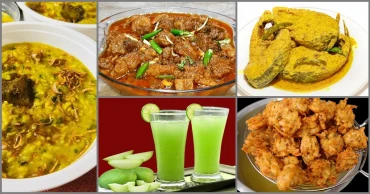Food
Public-private initiative needed to ensure production and supply of safe food
A combined effort of public-private partnership is needed in food production, inspection, and supply to the consumer level through trusted and committed entrepreneurs, a seminar on safe food was told on Thursday.
Speakers at the seminar said even when food is in a safe method, it is contaminated by use of harmful chemicals and preservatives during the process to supply to the consumers. Sometimes it is produced using unsafe chemicals and fertilizers, they said.
The seminar titled ‘'Strengthening smallholder farms and rural enterprises to better cope with climate change in the vulnerable haor regions of Bangladesh’ was held at the conference hall of Bangladesh Food Safety Authority (BSFA), in the capital on Thursday.
Bangladesh, Kuwait explore trade and food security ties
Dr. Md. Nazim Uddin, senior scientific officer of Bangladesh Agricultural Research Institute who is in charge of Bangladesh Organic Agriculture Network, in a keynote presentation highlighted different steps of safe food production, supply, and farm management.
Chairman of BFSA Zakaria noting some limitations said, “Mymensingh is home to 60 lakh people. There is only one food safety officer there. Now it is difficult to ensure food safety for so many people with just one person. And such a situation prevails everywhere.”
He said it is important for those involved in food production to have appropriate knowledge and training. To provide this training, BFSA is arranging online training. Those who need it can take training from here.
However, it is necessary to establish a training centre at the initiative of hotel owners to train hotel staff.
He said, “Education is needed for health safety. And a coordinated effort is needed to achieve this education. Our journey has started to ensure safe food, and this journey will continue.”
Director of the Department of Agricultural Extension Md. Shawkat Osman said, there is no alternative to organic fertilizers for safe food production.
Food Adviser calls for action against illegal food hoarding
However, it is not possible to produce sufficient agricultural products with organic fertilizers alone. Chemical fertilizers are needed. However, organic fertilizers can play a supporting role in this regard, he pointed out.
BSTI Director Md. Saiful Islam said that there is no alternative to social movements to increase food awareness. And political will is required for this social movement.
Because, “We are government employees, we have no power of our own. We have to do what is in the law,” he said mentioning limitation.
Fakir Muhammad Munawar Hossain, director of the National Consumer Rights Protection Department, said that to ensure safe food for consumers, it is necessary to ensure proper implementation of the law and increase social awareness.
“A social movement should be developed for social awareness to take safe food for the safety of health,” he pointed out.
CAB General Secretary Advocate Humayun Kabir Bhuiyan presided over the programme. The event was organized jointly by CAB and Friend In Village Development Bangladesh (FIVDB) with support of Welt Hunger Life.
11 months ago
Government aims to stabilize rice market, ensure trader support: Commerce Adviser
The government is committed to making business processes easier and providing full support to traders, Commerce Adviser Sheikh Bashir Uddin said on Tuesday. His remarks came during a meeting on rice stock and import situations at the Ministry of Commerce.
“Any problems faced by traders will be addressed promptly,” the adviser assured. The meeting was attended by Food Adviser Ali Imam Majumder along with key stakeholders.
Bashir Uddin highlighted the government's focus on tackling the price disparity between wholesale and retail rice markets, which has drawn public and industry concern.
“We aim to identify the root cause of this disparity and implement solutions for a stable market environment,” he said. While prices of most products have decreased, rice prices have seen a marginal rise. The adviser expressed optimism that rice prices would stabilize soon.
No change in duties until Ramadan ends: Finance Adviser
Food Adviser Ali Imam Majumder provided an update on the country’s food stock, which currently exceeds 1.2 million tonnes. Additionally, 100,000 tonnes of rice are expected to arrive from Myanmar this month as part of the government’s diversified import strategy.
The government is procuring rice from multiple neighboring countries under Government-to-Government (G2G) agreements to avoid over-reliance on a single source, Majumder said. He also discussed ongoing measures to support low-income families, including the distribution of rice through the Trading Corporation of Bangladesh (TCB) and the Open Market Sale (OMS) program.
“Fifty thousand families are receiving 30 kg of rice each under the food-friendly program,” he noted.
Deputy Governor of Bangladesh Bank Md Habibur Rahman announced that banks have been instructed to extend full cooperation in opening Letters of Credit (LCs) for food imports.
The meeting was attended by high-ranking officials, including Food Ministry Secretary Md Masudul Hasan, Tariff Commission Chairman Dr. Moinul Khan, Commerce Ministry Secretary Md Abdur Rahim Khan, TCB Chairman Brigadier General Md Mostafa Iqbal, and rice importer Aditya Majumdar.
11 months ago
How to Save Gas While Cooking at Home
With the rising cost of gas cylinders in Bangladesh, every bit of gas you save counts. Learning to save gas while cooking at home helps you save money and contributes to a more sustainable environment. Let’s explore effective tips to save cooking gas in rural and urban home kitchens.
Ways to Save Gas While Cooking in Home Kitchens
Cook with a Lid On
Cooking with a lid on your pots and pans is a simple yet highly effective way to conserve gas. The lid traps heat inside the cookware, allowing food to cook more quickly and evenly. Without a lid, much of the heat escapes into the air, leading to longer cooking times and increased gas consumption.
By consistently covering your pots and pans, you can significantly reduce the amount of gas required for cooking. This small adjustment saves energy and speeds up meal preparation, making your kitchen more efficient.
Read more: Fridge Smells Bad? Reasons and How to Get Rid of It
Opt for Smaller Burners
Choosing the right burner size for your cookware is crucial for efficient gas usage. When cooking with a small pot or pan, it is best to use a smaller burner. A large burner under a small pot wastes gas because the flame extends beyond the cookware, releasing heat into the air instead of focusing it on the pot.
Matching the burner size to the cookware ensures that all the heat is directed where it is needed which reduces cooking time and gas consumption. This simple habit can make a noticeable difference in your gas usage.
Batch Cooking
Batch cooking is a strategic way to save gas by preparing multiple meals at once. Instead of cooking individual meals throughout the week, you can cook larger quantities in one go, using the gas stove for a shorter overall time.
Read more: 10 Tasty Bangladeshi Recipes with Flu-fighting Nutrients
Once cooked, these meals can be stored in the refrigerator or freezer and reheated later, which requires far less gas than cooking from scratch. This approach saves gas also time and effort during busy weekdays. By planning and preparing meals in batches, you can optimise gas usage and enjoy ready-to-eat meals.
Soak Grains and Pulses
Soaking grains, pulses, and beans before cooking is an excellent method to reduce cooking time and save gas. When these ingredients are soaked, they absorb water and soften, which significantly shortens the time needed to cook them.
For instance, soaked lentils can cook in a fraction of the time compared to unsoaked ones, meaning you will use much less gas. Additionally, soaking helps to break down complex carbohydrates, making the food easier to digest. Incorporating this simple step into your cooking routine can lead to both energy savings and improved meal quality.
Read more: 10 Tasty Ilish Recipes for Bangladeshi Kitchen
Use Flat-bottomed Cookware
Flat-bottomed cookware is essential for efficient cooking and gas conservation. Pots and pans with a flat base make better contact with the stove, allowing for even heat distribution across the entire surface. This reduces cooking time and ensures that the heat is used effectively, rather than being wasted.
In contrast, warped or uneven cookware can result in uneven cooking and longer cooking times, leading to unnecessary gas consumption. Investing in good quality, flat-bottomed cookware can improve your kitchen’s efficiency, helping you save both time and gas while preparing meals.
Keep Burners Clean
Maintaining clean burners is key to ensuring your gas stove operates efficiently. Over time, food spills, grease, and debris can clog the burner openings, leading to uneven gas flow and a weaker flame. This inefficiency not only makes cooking slower but also increases gas consumption.
Read more: 10 Easy Snack Ideas to Stay Energized During Office Hours
Regularly cleaning your burners helps maintain a steady, strong flame, which allows for faster and more efficient cooking. A well-maintained stove saves gas and extends the life of your appliance. This makes it a worthwhile habit to adopt for both energy savings and kitchen safety.
Simmer, Don’t Boil Vigorously
After bringing food to a boil, reducing the heat to a simmer can significantly cut down on gas usage. Many people mistakenly believe that boiling food vigorously cooks it faster, but in reality, it only wastes gas.
Simmering, which involves cooking at a lower, steady heat, is just as effective and far more efficient. Once your food reaches the boiling point, lowering the flame and allowing it to cook gently will ensure that you are not using more gas than necessary. This method saves energy and often results in better-tasting food.
Read more: How to Safely Enjoy Street Food in Bangladesh
Turn Off the Gas Early
Turning off the gas a few minutes before your food is fully cooked is an effective way to conserve energy. The residual heat in the pot or pan continues to cook the food even after the gas is turned off, meaning you can save gas without compromising the quality of your meal.
This technique works particularly well for dishes like rice, pasta, and vegetables, which can finish cooking in the retained heat. By adopting this practice, you can gradually reduce your gas usage and make your cooking routine more efficient.
Plan Your Meals
Meal planning is an excellent strategy for optimising gas usage in the kitchen. By planning your meals, you can prepare dishes that require similar cooking times or temperatures, reducing the need to keep the stove on for extended periods.
Read more: Induction Cooker price in Bangladesh with Buying Tips
For example, you might cook multiple items simultaneously or use the residual heat from one dish to start another. Additionally, planning helps you avoid last-minute cooking, which can lead to inefficient use of gas. A well-organised meal plan saves energy as well as makes your cooking process more streamlined and stress-free.
Use the Right Size of Cookware
Using cookware that matches the size of your burner is crucial for efficient gas consumption. A small pot on a large burner results in wasted gas, as the excess flame spills out around the pot instead of heating it directly.
Conversely, using a large pot on a small burner can lead to longer cooking times, as the heat is insufficient to cook the food efficiently. To maximise gas efficiency, always choose cookware that corresponds to the size of the burner. This simple adjustment ensures that the heat is focused where it is needed, reducing gas usage and cooking time.
Read more: Deep Fryer price in Bangladesh with Buying Tips
Gas Stove Maintenance
Regular maintenance of your gas stove is essential for optimal performance and preventing gas leaks, which can be both wasteful and dangerous. Over time, burners can become clogged, and gas lines can develop leaks, leading to inefficient cooking and potential safety hazards.
By scheduling regular check-ups and cleaning for your stove, you ensure that it functions correctly and uses gas efficiently. This saves energy and extends the lifespan of your appliance. Proper maintenance is a small investment that pays off in reduced gas bills and a safer kitchen environment.
Explore Alternatives: Pressure Cooker and Other Methods
Exploring alternative cooking methods can further reduce your reliance on gas. Using a pressure cooker is one of the most efficient ways to save gas in the kitchen. Pressure cookers work by trapping steam inside, which increases the pressure and temperature, allowing food to cook faster. Whether you are preparing rice, lentils, or meat, a pressure cooker can cut cooking times by half or more. Moreover, pressure cooking retains more nutrients in the food, making it a healthier option. For frequent cooking, opting for a pressure cooker can lead to substantial gas savings.
Read more: Microwave Oven price in Bangladesh with Buying Tips
You can also use an induction cooker, electric stove, solar cooker, or microwave to complement your gas stove, especially on sunny days or when cooking smaller meals.
Using these electric cooking appliances, you can use much less gas compared to traditional cooking methods. While the initial investment might seem significant, the long-term savings on gas can make it worthwhile. Additionally, these alternatives often have faster cooking times and can be more energy-efficient for certain tasks. By diversifying your cooking methods, you can reduce your overall gas consumption, lower your utility bills, and contribute to a more sustainable lifestyle.
Final Words
Saving gas while cooking at home is not just about cutting costs but also about adopting smarter cooking practices that benefit your household and the environment. By implementing these simple tips, you can make your cooking process more efficient, reduce your gas consumption, and contribute to a greener world. Start making these changes today, and enjoy the benefits of more economical and eco-friendly cooking.
Read more: Microwave Cooking: 7 Healthy Chicken Breast Recipes
1 year ago
Delicious Pasta Recipes for Bangladeshi Home Kitchens
During this inflation, homemade food saves money. Cooking pasta at home allows you to explore various flavours and create delicious dishes that suit your taste buds. Whether you prefer something rich and cheesy or spicy and tangy, pasta is a versatile dish that can be transformed into a wide range of mouthwatering recipes. Here are some delightful pasta recipes you can easily prepare in your home kitchen.
7 Mouthwatering Homemade Pasta Recipes for Bangladeshi Kitchens
Cheesy Pasta
Ingredients
450 grams uncooked pasta, ¼ cup butter, ½ cup milk, ½ cup cubed Gouda cheese, ½ cup cubed sharp Cheddar cheese, ¼ cup grated Parmesan cheese, ¼ cup blue cheese dressing, 1 clove garlic (crushed), paprika to taste, salt and pepper to taste.
Instructions
First, boil a large pot of lightly salted water and cook the pasta for 8 to 10 minutes, until it reaches an al dente texture. Drain the pasta and place it back into the pot.
Then, add the butter, garlic, Cheddar cheese, Gouda cheese, and Parmesan cheese in the same pot. Cook and stir over low heat. Do not use too much heat to prevent the cheese become stringy. Next, gradually stir in the blue cheese dressing and milk, continuing to cook until the pasta is evenly coated. Season with paprika, salt, and pepper. This recipe is ideal for those who love a comforting and cheesy meal.
Read more: Delightful Recipes from Bangladeshi Kitchens to Savor on Rainy Days
Spicy Chicken Pasta
Ingredients
250 grams of uncooked pasta, 2 chicken breasts, 1 teaspoon garlic powder, 1 teaspoon onion powder, 1 teaspoon smoked paprika, 1/8 teaspoon cayenne pepper (to taste), salt and pepper to taste, 2 tablespoons olive oil, 2 cloves garlic minced, ½ cup chicken broth, 400 grams crushed tomatoes, ½ teaspoon crushed red pepper flakes (to taste), 1 pinch of sugar (optional, to taste), 2 cups fresh baby spinach, 1/4 cup fresh basil (chopped), and freshly grated parmesan cheese (optional, for serving).
1 year ago
Delightful Recipes from Bangladeshi Kitchens to Savor on Rainy Days
Rainy days bring a sense of tranquility and comfort, as the pitter-patter of raindrops creates a soothing melody. Amidst the serenity, there is nothing like indulging in hearty, flavourful dishes that warm the soul. In Bangladeshi kitchens, rainy days call for special recipes that elevate the culinary experience. From spicy curries to tangy delights, here are five special recipes perfect for a rainy day retreat at home.
5 Special Recipes to Try at Home on Rainy Days
Achari Letka Khichuri
Ingredients
½ cup of rice, 1/4th cup of masoor dal/red lentils, 1/4th cup of moong dal/yellow lentils, 1 onion (thinly sliced), 2 cloves of garlic (roughly chopped), 4 green chillies, 1 teaspoon panchforon, 1 dry red chilli, 1 teaspoon turmeric powder, 1 teaspoon red chilli powder, 1 teaspoon garam masala powder and ½ teaspoon cumin powder, 3 tablespoons of mustard oil, 2 tablespoons of mango pickle, some green peas, salt and sugar, and warm water.
Instructions
First, combine rice and two types of lentils in a bowl. Then, wash them thoroughly. Add chopped onion, minced garlic, turmeric powder, red chilli powder, garam masala powder and cumin powder.
Read more: Delicious Oatmeal Recipes for Weight Loss
Then pour in mustard oil and a pinch of salt, mixing everything well. Leave it to marinate for 15 minutes. Now, heat 1 tablespoon of mustard oil in a pan, then add panchforon and dry red chilli. Next, sauté the ingredients briefly. After that, add the rice-lentil mixture, and cook for 3 minutes.
Next, add 2 cups of warm water, salt, green chillies, green peas, and a pinch of sugar. Let it boil, then lower the heat and simmer covered for 15-20 minutes until the ingredients are tender. Stir in sour mango pickle and cook for an additional 5 minutes. Let it rest for 2 minutes before serving.
1 year ago
Beat Dehydration with These Summer Vegetables
As the temperatures soar during the scorching summer months, it becomes increasingly crucial to prioritise hydration. Dehydration occurs when the body loses more fluids than it takes in. Dehydration may lead your body to adverse effects ranging from fatigue and headaches to more severe complications like heatstroke. While it is common knowledge to increase water intake during hot weather, many overlook the hydrating potential of the summer vegetables.
Why Incorporate Summer Veggies into Your Diet
Maintaining adequate hydration levels is crucial for maintaining overall health and well-being. Water is essential for regulating body temperature, aiding digestion, transporting nutrients, and flushing out toxins. Dehydration can lead to a range of adverse effects, including fatigue, headaches, dizziness, and even more severe complications like heatstroke.
By staying adequately hydrated, you can enhance cognitive function, improve physical performance, and support organ function. Make it a priority to drink water regularly throughout the day to ensure optimal hydration and vitality, especially in the summer heat.
Read more: How to Protect Your Skin and Hair from Sun Damage
Summer veggies are rich in diverse vitamins and nutrients. Adding vegetables to regular meals can help you stay hydrated and healthy during the warmer months. Let’s take a look into some nutritious summer veggies to fight dehydration this summer.
Nutritious Summer Vegetables to Beat Dehydration
.
Cucumber
Cucumbers are hydrating vegetables packed with nutrients like vitamins A, B, and C, along with minerals such as potassium and magnesium. With a water content over 95%, they replenish lost fluids and electrolytes, aiding hydration.
Enjoy cucumbers sliced in salads, sandwiches, or refreshing cucumber mint smoothies for a hydrating boost. Incorporating cucumbers into your diet regularly can promote skin health, aid digestion, and support overall well-being. Aim for at least one or two cups of cucumber daily to reap its hydrating benefits.
Read more: Summer Safety Tips for Elderly to Avoid Heat-related Illnesses
Tomatoes
Tomatoes are hydrating vegetables boasting a water content of around 94%. Rich in vitamins A and C, along with antioxidants like lycopene, they support immune function and promote heart health. You may incorporate tomatoes into your diet to enjoy their hydrating benefits.
Try them tossed in salads or sandwiches, blended into soups, or roasted with herbs for a flavourful side dish. It is recommended to include 1 or 2 tomatoes in your meals regularly to hydrate your body and boost your health.
Bell Peppers
Bell peppers, with a water content of approximately 92%, are hydrating vegetables rich in vitamins A, C, and K, as well as antioxidants. They support immune function, promote healthy vision, and reduce inflammation. You can incorporate bell peppers into your meals to enjoy their hydrating benefits.
Read more: 7 Comforting Soups for Upset Stomach
Add them to stir-fries, salads, or stuffed pepper recipes for a colourful and nutritious dish. Experts suggest limiting having one bell pepper in a day in your diet to stay hydrated and nourished, especially during hot weather without causing bloating or gas.
Lettuce
Lettuce varieties like iceberg and romaine are primarily composed of water. It is a hydrating vegetable that provides essential nutrients like vitamins A, K, and C, as well as folate and iron. It supports healthy skin, boosts immunity, and aids digestion.
Try to include lettuce in your diet for hydration and nutrition. Use it as a base for salads, wraps, or sandwiches for a refreshing and low-calorie meal option. Enjoy lettuce regularly to stay hydrated and promote overall well-being, aiming for around or less than two cups of green leaf lettuce per day.
Read more: 5 Mouth-watering Mango Pickle Recipes to Cherish This Summer
Spinach
Spinach, packed with water, is a hydrating vegetable loaded with vitamins A, C, and K, along with iron, potassium and folate. It supports bone health, boosts immunity, and aids in blood clotting.
Add one handful of spinach daily into your diet for hydration and nutrition. Add it to salads, smoothies, or cooked dishes for a nutritious boost. These can help you to stay hydrated and reap its numerous health benefits.
1 year ago
Rooftop Restaurants in Dhaka’s Mohammadpur for Delicious Food and Instagram Photos
Are you looking for an Instagrammable place to spend some quality time with good food while taking in the view of the city from a considerable height? In this bustling city of Dhaka, a rooftop restaurant can be a beautiful getaway that offers a glimmering view of the skyline and a serene escape from the crowded streets below. Located in Dhaka’s north, Mohammadpur has several Instagram-worthy rooftop restaurants with enchanting views and a cozy laid-back atmosphere. Let’s check them out.
6 Instagrammable Rooftop Restaurants at Mohammadpur in Dhaka
Rainforest Café
Rainforest Café is another great option for rooftop dining with friends and family. The café is located on Tajmahal Road right on the main street. The management undertook renovations recently to revamp the look of the café. There’s a large indoor sitting area perfect for large groups. Adjacent to that is the kid’s play area.
The outdoors has been tastefully decorated with trees, shrubs, and a fish aquarium. Each table has been made into a hut-like structure giving it a forest-like look.
Read more: Top 10 Dhaka Restaurants with Outdoor Seating
The café serves oriental, Chinese, and Italian cuisines. There’s a curated Chinese platter for students as well.
Rainforest Café remains open from 11 AM to 11 PM every day.
Garden SHIP
Located on Taj Mahal Road, Garden SHIP is your typical family restaurant with a great ambiance. The restaurant is beautifully designed to give it a ship-like look on the inside. The large spacious indoor seating is perfect for group or family dine-outs.
Read more: Best Instagrammable Rooftop Restaurants at Gulshan in Dhaka
The back of the restaurant has their cozy rooftop section. It offers a beautiful view overlooking the greenery of the Dhaka Residential Model College.
Garden SHIP has a wide variety of menus. From Thai, Chinese, Indian to seafood, the restaurant offers something for everyone. The operating hours are from 11 AM to 11 PM every day.
Spicy6
Spicy6 is located on Ring Road, Mohammadpur. The restaurant is famous among the locals for its Thai, Chinese, Oriental, and South Asian cuisines. Spicy6 offers great indoor and outdoor arrangements with faux grass and overhead shades.
Read more: Instagrammable Rooftop Restaurants in Uttara
1 year ago
Bangladesh Safe Food Authority proposes new regulations to combat misleading food advertisements
In a significant move towards ensuring food safety and consumer protection, the Bangladesh Safe Food Authority (BFSA) hosted a meeting on Monday to present and solicit feedback on the "Safe Food (Advertisement and Claims) Regulations, 2024." Held in the BFSA training room, the gathering aimed at refining the draft regulation, which comprises 16 comprehensive articles addressing various aspects of food advertising and claims.
Under the proposed regulation, penalties will be imposed for false advertising, use of language that offends community sentiments, obscene content, and false superiority claims about food products. The draft meticulously outlines conditions for advertising, including nutrition and no-salt claims, use of additives, health support claims, and prohibited claims. It also details the process for handling advertising complaints and the penalties for non-compliance.
Read: Ghorer Bazar offers safe food products, focusing on health, sustainability
Abdul Qayyum Sarkar, Chairman of the BFSA, chaired the meeting and encouraged the integration of stakeholder feedback into the final regulations. The session featured discussions led by notable participants, including Rezaul Karim, former BFSA member, and Nazma Begum, who delivered the welcoming address.
Highlighting the regulations' objectives, Nazma Begum stated, "These regulations aim to halt misleading or inaccurate advertisements by considering consumer demands and adhering to Codex principles."
Read: Ensure safe food: Food minister
Professor Razia Begum of Dhaka University's Department of Marketing emphasized the importance of strict enforcement and broad media dissemination post-implementation. The event saw active participation from representatives of various food establishments, who contributed their insights, with the BFSA assuring consideration of all input received.
Nazneen Akhter, a scientific officer at the BFSA, presented the keynote, while the meeting was moderated by Sheikh Ferdous Arafat, a law officer at the authority. This initiative represents a critical step toward enhancing food safety standards and consumer trust in Bangladesh.
Read more: First 'Safe Food Carnival' in the country starts from Feb 8
1 year ago
Bangladeshi-American chef shortlisted for the ‘Oscars of food’
In a remarkable achievement, Bangladeshi-born American Chef Nur-E Gulshan Rahman has been shortlisted for the Best Chef in the Mid-Atlantic category by the James Beard Foundation. Chef Rahman's culinary prowess shines at Korai Kitchen, a hidden gem in Jersey City, renowned for its authentic Bangladeshi cuisine.
The James Beard Foundation Awards, often dubbed the “Oscars of food,” honor excellence across America's culinary spectrum. These prestigious awards celebrate the artistry and innovation in the culinary field, recognizing the best chefs and restaurants.
Despite its modest beginning, as reported by the New York Times, Korai Kitchen has carved a niche in Jersey City's vibrant culinary scene. Chef Rahman's eatery has earned accolades for its authentic Bangladeshi flavors and homestyle cooking.
An emotional social media post from the restaurant celebrated this milestone: “Amma was nominated for a James Beard Award today!! Words cannot express just how proud I am of my mom and our incredible team. What a beautiful moment of recognition for Bangladeshi food and for my insanely talented mother, who has honed her craft for over FIFTY YEARS!”
Read more: Kishwar wins Australians hearts with her Bangladeshi recipe on Masterchef
The post added, “My mom would sometimes say she felt like an imposter because she has no formal culinary training. Amma, you've shown that it's not culinary school that makes a chef; it's passion, talent, grit, and love.”
Korai Kitchen, described by the New York Times, offers an immersive experience akin to dining in a Bangladeshi home. The restaurant features a rotating buffet of dishes, including bhorta (mashes) and light curries, all prepared under the watchful eye of Chef Rahman. It's a celebration of slow food — homestyle Bangladeshi dishes crafted with care and affection.
Since their inception in 1990, the James Beard Awards have set a benchmark for culinary excellence. The outstanding chef category, in particular, honors chefs who not only uphold high culinary standards but also positively influence their peers and make a significant impact on the wider community. Chef Rahman's nomination is a testament to her dedication and skill, bringing the rich flavors of Bangladesh to the American culinary landscape.
Read more: AI Robot Chefs: Automated Cooking Could Redefine Food Industry
1 year ago
Superfoods: Worth the Hype?
In recent years, the term "superfood" has garnered significant attention in health and wellness. These foods are often touted as nutritional powerhouses. They are praised for their exceptional health benefits.
The buzz around superfoods stems from their purported ability to provide a high concentration of nutrients, antioxidants, and other health-promoting compounds. Now, the questions arise, what exactly qualifies as a superfood, and is the hype surrounding the superfoods justified?
Are Superfoods Worth the Hype?
Superfoods are nutrient-rich foods often hailed for their exceptional health benefits. They typically contain high levels of vitamins, minerals, antioxidants, and other essential nutrients that contribute to overall well-being. Superfoods include blueberries, spinach, salmon, chia seeds, and kale.
The term “superfoods” was coined in the 1990s. But it became widely familiar in 2007 after being mentioned in an article in Time Magazine. While the term "superfood" might spark intrigue, it is essential to approach the concept with a critical eye.
Read more: Popular Winter Breakfasts in Bangladesh
Scientific evidence supporting the extraordinary health claims of superfoods varies. While some foods offer remarkable nutritional values, others might not live up to the exaggerated claims. Assessing the actual worth of superfoods involves understanding their nutritional content, benefits, and limitations.
Tips for Incorporating Superfoods into Your Diet
Seeds as Garnish
Seeds like chia seeds, pumpkin seeds, and hemp seeds have gained attention as superfoods due to their rich nutrient profiles. They are packed with proteins, healthy fats, fibre, vitamins, and minerals.
These tiny seeds work excellently as garnishes. Their subtle taste makes them perfect for enhancing the nutritional value of dishes and snacks without overpowering the flavours.
Dark Chocolate Desserts
Contrary to popular belief, dark chocolate is a nutrient-rich superfood. It is abundant in antioxidants and various essential nutrients. It is a versatile ingredient for desserts and can serve as a flavour enhancer.
Read more: 10 Bangladeshi Winter Street Foods: Taste Meets Tradition
For instance, you may have strawberries or banana slices dipped in dark chocolate for an antioxidant-rich dessert. It offers a delicious pre-workout snack or an evening dessert.
Nuts as Snacks
Nuts are another nutrient-dense superfood group. It delivers proteins and omega-3 fatty acids and is ideal for plant-based diets. They make for a satisfying and healthier snack option between meals and keep hunger at bay. Nuts serve as a convenient way to boost nutrition and resist unhealthy snacking both at work or home .
Cauliflower Rice
Cauliflower is a superfood due to its nutrient content like protein, vitamins, and minerals. But it is often overlooked. Cauliflower can replace potatoes and is excellent as an alternative to regular or brown rice. To prepare cauliflower rice first, boil the florets, then cool them. Now process them in a mixer. Your cauliflower rice is ready to be savoured.
Read more: 5 Tasty Savoury Winter Pitha Recipes for Bangladeshi Kitchen
Yoghourt Desserts
Yoghourt is a versatile and nutrient-packed superfood that serves as a savoury side or a base for desserts. Yoghourt can be paired with granola, dark chocolate, or naturally sweet berries. It creates effortless and nutritious dessert cups.
Berries Candy
Berries such as strawberries and blueberries make a healthy substitute for candies. You need to transform them into candy-like treats by squeezing lemon over the berries and refrigerating them for a few hours. This trick works with citrus fruits like oranges too.
Green Iced Tea
For a refreshing and nutritious drink, you may try iced green tea. It is packed with nutrients and is known to boost metabolism. Green tea infused with ice, lemon, and honey offers a superfood-packed beverage.
Read more: 5 Tasty Sushi Recipes for Bangladeshi Kitchen
Garlic Olive Oil
Both garlic and olive oil qualify as superfoods. They are rich in nutrients and known for their healing properties. Creating garlic-infused olive oil serves as a healthier alternative to butter for toast toppings. You need to simply combine olive oil with peeled garlic cloves and bake to prepare this delicious garlic olive oil.
1 year ago



















